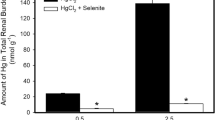Conclusion
The most striking conclusion from this experiment is that dietary selenium influences the distribution of mercury in tissues of rats exposed to occupational amounts of metallic mercury in the air. Moreover increased dietary selenium does not increase the tissue retention of mercury contrary to earlier investigations. Finally HgO and Hg++ seems to be distributed by different routes in the rat brain.
As a corollary it must be emphasized that blood mercury values are not a valid indicator of mercury exposure i.a. due to the fact that dietary selenium influences the mercury concentration in the blood.
Further research of the geographical distribution of dietary selenium should be carried out before evaluation of environmental and occupational exposure of mercury can be carried out.
Similar content being viewed by others
References
HAFEMAN, D.G. et al.: J.Nutr.104, 580 (1974).
SCHWARZ, K.: Med. Clin. North Am.60, 745 (1976).
WELSH, S.: Physiological Effects of Methyl Mercury toxicity: Interaction of Methyl Mercury with Selenium, Tellurium, and Vitamin E. University of Maryland 1974.
Author information
Authors and Affiliations
Rights and permissions
About this article
Cite this article
Nygaard, SP., Hansen, J.C. Mercury-selenium interaction at concentrations of selenium and of mercury vapours as prevalent in nature. Bull. Environ. Contam. Toxicol. 20, 20–23 (1978). https://doi.org/10.1007/BF01683479
Issue Date:
DOI: https://doi.org/10.1007/BF01683479



